Multiple piece construction automotive door hinge
a technology of automotive doors and hinges, applied in the field of hinges, can solve problems such as material interference and create, and achieve the effect of reducing or eliminating scrapping
- Summary
- Abstract
- Description
- Claims
- Application Information
AI Technical Summary
Benefits of technology
Problems solved by technology
Method used
Image
Examples
Embodiment Construction
[0032]Referring to FIGS. 3, 4, 5, and 6, an automotive hinge assembly (30) is substantially constructed from a door component (40) and a body component (60). The door component is configured with a mounting surface (41) and two pivot arms (42). Each pivot arm (42) contains a pivot axis hole (43). The door component (40) is structurally attached to a vehicle closure panel (27) via its mounting surface (41) using bolting, welding, bonding, riveting or similar fastening means. The body component (60) is configured with a mounting surface (61) and a pivot arm (62). The pivot arm (62) contains a pivot axis hole (63). The body component is structurally attached to a vehicle body structure (28) via its mounting surface (61) using bolting, welding, bonding, riveting or similar fastening means. The pivot axis hole (63) of the body component (60) is fitted with a pivot bushing (80) that contains an internal cylindrical bearing surface (81) and two opposing thrust flanges (82). Referring to FI...
PUM
 Login to View More
Login to View More Abstract
Description
Claims
Application Information
 Login to View More
Login to View More - R&D
- Intellectual Property
- Life Sciences
- Materials
- Tech Scout
- Unparalleled Data Quality
- Higher Quality Content
- 60% Fewer Hallucinations
Browse by: Latest US Patents, China's latest patents, Technical Efficacy Thesaurus, Application Domain, Technology Topic, Popular Technical Reports.
© 2025 PatSnap. All rights reserved.Legal|Privacy policy|Modern Slavery Act Transparency Statement|Sitemap|About US| Contact US: help@patsnap.com

